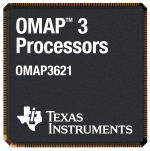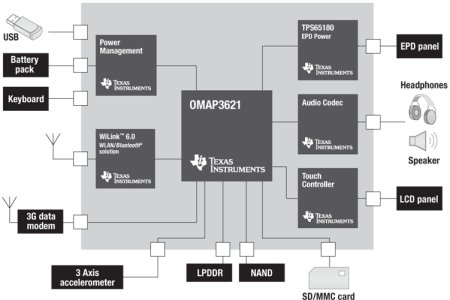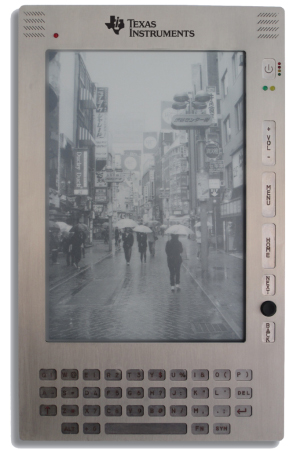E-reader platform taps 45nm Cortex SoC
Jan 7, 2010 — by Eric Brown — from the LinuxDevices Archive — 3 viewsTexas Instruments (TI) announced an e-book reader development platform for Linux and Android, based on its OMAP3621 system-on-chip. The eBook Development Platform is equipped with an E Ink electrophoretic EPD display, TI's new TPS6518x EPD power management IC, plus an integrated WiLink chip (WiFi, Bluetooth, and FM) and 3G support.
The eBook Development Platform is the result of the latest of several recent collaborations between E Ink and semiconductor firms designed to develop processors and display controllers optimized for the grayscale e-reader display platform. For example, in October, E Ink announced a deal with Freescale Semiconductor to integrate Freescale's i.MX processor technology and the latter's Vizplex display controller. In November, it announced a somewhat similar deal with Marvell Semiconductor.
The TI eBook platform is based on a newly sampling, 45nm-fabricated, ARM Cortex-A8-based OMAP3621 system-on-chip (SoC), which incorporates Imagination PowerVR3D graphics acceleration and TI's C64x+DSP (digital signal processor) technology for multimedia acceleration. 
Announced along with four other 45nm, die-shrunk versions of the OMAP34x family back in February of last year, the OMAP3620 family is clocked to 720MHz, and corresponds to the earlier OMAP3420 SoC. The key benefit of the OMAP3621 is that it fits into a small 12 x 12mm, 0.5mm ball pitch package with low power DDR memory support, reducing footprint and power consumption, says TI.
In addition to incorporating the OMAP3621, the eBook Development Platform offers an E Ink Vizplex electrophoretic electronic paper display (EPD), but targets a variety of e-reader designs, including those with secondary displays, says the company.
TI's eBook Development Platform
(Click to enlarge)
The eBook design includes a DSP-based software display controller, which drives the electrophoretic display. By using a software controller, total silicon footprint is reduced by more than 200 square millimeters, leading to reduced hardware cost, says TI. Device designers can therefore eliminate a hardware EPD controller, dedicated external flash to store waveforms, and dedicated SDRAM for the frame buffer, says the company.
Designers can avoid external temperature sensors, as well, as these are embedded into TI's new TPS6518x display power management IC, says TI. The IC is also said to be able to automate the setting of the VCOM voltage via an I2C interface.
In addition to supporting electrophoretic displays, the platform supports electromechanical, electrowetting and thin-film transistor LCDs. Although the reference design offers only a single EPD display, the platform also supports dual-screen designs, including color displays, says TI. Additional supported features are said to include text-to-speech, with FM and Bluetooth streaming to an external audio device like a car radio.
TI's eBook Development Platform enables more than 14,800 page turns on a 6-inch E Ink screen using a slim 600 mAh battery — a 50 percent improvement over similar solutions, claims TI. The design is claimed to enable users to read a 500-page book approximately 20 times on a single battery charge.

eBook Development Platform block diagram
(Click to enlarge)
The design ships with full reference schematics and design layout files, as well as 3G modem support, 3-axis accelerometers, and various TI power management and analog components. The software development platform supports Linux and Android, and offers hardware device drivers, optimized power management, software display controller, and drivers for WLAN, Bluetooth, and FM radios.
Testimonials
TI offered testimonials from several partners who appear to be using the platform to develop e-readers or e-reader components. These include BooKeen, Ninestars Information Technologies Limited, SiPix Imaging Inc., LiquaVista, Loquendo, and multi-touch technology firm Sensitive Object.
Stated Sriram Peruvemba, VP of Marketing at E Ink, "We are excited by the promise of TI's technology and the innovation it will drive in the ePaper market. Our mutual customers in the eBook market will benefit from enhanced features, greater flexibility, reduced component count and lower system costs."
Stated Elie Belmand, GM of TI's mobile consumer business, "Today, we are working with more than ten leading eBook OEM and ODMs to bring compelling, new eBook devices to store shelves in 2010. Our eBook platform provides a comprehensive and solid foundation to allow these manufacturers to shorten their product development cycle times while delivering innovative devices that will 'wow' consumers and help propel the eBook market forward."
Availability
The eBook development platform is available today for high-volume e-book reader manufacturers, with volume production expected in the first quarter, says TI. The OMAP3621 processor is sampling now, says TI. Samples of the TPS6518x display power management IC can be ordered at TI, here.
More information on the eBook Development Platform and the OMAP3621 may be found here.
This article was originally published on LinuxDevices.com and has been donated to the open source community by QuinStreet Inc. Please visit LinuxToday.com for up-to-date news and articles about Linux and open source.
